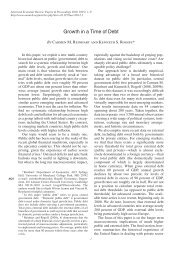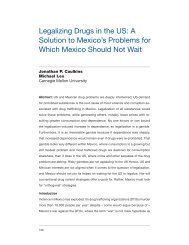The collapse of global trade, murky protectionism, and the crisis:
The collapse of global trade, murky protectionism, and the crisis:
The collapse of global trade, murky protectionism, and the crisis:
You also want an ePaper? Increase the reach of your titles
YUMPU automatically turns print PDFs into web optimized ePapers that Google loves.
<strong>The</strong> <strong>collapse</strong> <strong>of</strong> <strong>global</strong> <strong>trade</strong>, <strong>murky</strong> <strong>protectionism</strong>, <strong>and</strong> <strong>the</strong> <strong>crisis</strong><br />
ton production <strong>and</strong> <strong>the</strong> decline in lint cotton export. <strong>The</strong> balance <strong>of</strong> <strong>trade</strong> sharply<br />
deteriorated under <strong>the</strong> combined impact <strong>of</strong> falling agricultural production <strong>and</strong><br />
declining lint cotton export (from CFAF 160 million in 2007 to CFAF 12 million in<br />
2008). <strong>The</strong> current account deficit is estimated at 12.9% <strong>of</strong> GDP in 2008, a 3.8 point<br />
decline compared to 2007. O<strong>the</strong>r commodity exporters face <strong>the</strong> same situation,<br />
which largely explains <strong>the</strong> very negative growth outlook for 2009 in <strong>the</strong> continent.<br />
Hence, it is critical that <strong>the</strong> world takes all measures to support <strong>trade</strong>. In particular,<br />
all countries should refrain from <strong>trade</strong> distorting export subsidies given <strong>the</strong>ir damaging<br />
effects not only on growth but also on <strong>the</strong> living st<strong>and</strong>ards <strong>of</strong> <strong>the</strong> poor.<br />
Procyclicality <strong>and</strong> declining <strong>trade</strong> volumes<br />
Generally, government spending in most countries are cyclical in nature, meaning<br />
that expenditure tends to increase with <strong>the</strong> good times. It was not surprising that<br />
most resource rich countries in Africa raised <strong>the</strong>ir public investment levels as <strong>the</strong>ir<br />
<strong>trade</strong> volumes surged.<br />
What measures should African countries take to <strong>of</strong>fset <strong>the</strong> fall in government revenue<br />
linked to declining <strong>trade</strong> volumes?<br />
It is important for countries to focus on <strong>the</strong> big decisions that ensure sustainable<br />
growth. <strong>The</strong>se priorities include low debt levels, higher investment in infrastructure,<br />
improving <strong>the</strong> investment climate, <strong>and</strong> boosting <strong>trade</strong>. Countries such as South<br />
Africa, which have been severely hit by <strong>the</strong> financial <strong>crisis</strong>, have now adopted countercyclical<br />
policies to meet <strong>the</strong> financing gap for development needs as a result <strong>of</strong> <strong>the</strong><br />
freezing up <strong>of</strong> funds in <strong>the</strong> credit market. In this regard, South Africa will revert to <strong>the</strong><br />
status <strong>of</strong> a net issuer <strong>of</strong> debt in 2009. O<strong>the</strong>r countries in similar situations should be<br />
encouraged to use domestic instruments such as bonds <strong>and</strong> tax revenue to <strong>of</strong>fset <strong>the</strong><br />
loss in fiscal space due to declining <strong>trade</strong> volumes.<br />
Infrastructure <strong>and</strong> African <strong>trade</strong><br />
Infrastructure remains a key factor for facilitating <strong>trade</strong> <strong>and</strong> anchoring o<strong>the</strong>r economic<br />
services. Trade in Africa is atypically costly, both in terms <strong>of</strong> direct <strong>and</strong> indirect<br />
costs.<br />
It is estimated that <strong>trade</strong> costs represent up to 30% <strong>of</strong> <strong>the</strong> price paid by <strong>the</strong> consumer.<br />
Moreover, freight costs constitute about 10% <strong>of</strong> <strong>the</strong> value <strong>of</strong> imports in Africa<br />
<strong>and</strong> o<strong>the</strong>r developing countries, compared to 3% in developed countries. For l<strong>and</strong>locked<br />
countries <strong>the</strong> challenge is even more daunting. Freight costs account for over<br />
20% <strong>of</strong> <strong>the</strong> value <strong>of</strong> imports for Rw<strong>and</strong>a, 24% for Mali <strong>and</strong> 23% for Niger. In addition,<br />
delays at border posts account for about 40% <strong>of</strong> transport time, <strong>and</strong> imply immense<br />
costs associated with <strong>the</strong> deterioration <strong>of</strong> product quality <strong>and</strong> staff time. <strong>The</strong> high<br />
costs are due to inadequate physical infrastructure such as roads <strong>and</strong> ports, causing<br />
long delays in <strong>the</strong> <strong>trade</strong> chain.<br />
<strong>The</strong> road infrastructure network in Africa is inadequate, inefficient <strong>and</strong> poorly<br />
managed. <strong>The</strong> road density in Africa is only 7 kilometres per 100 square kilometres<br />
compared to 12 kilometres in Latin America, <strong>and</strong> 18 kilometres in Asia. Only 30% <strong>of</strong><br />
<strong>the</strong> region's roads are paved <strong>and</strong> many are inaccessible during <strong>the</strong> rainy season. In<br />
addition, ports are in inadequate supply, overloaded, <strong>and</strong> inefficient. <strong>The</strong> shipping<br />
fleet is also inadequate with vessels that are too small, too few, <strong>and</strong> <strong>of</strong>ten in poor<br />
61





